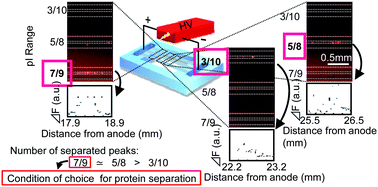This report describes the fabrication and characterization of a simple and disposable capillary isoelectric focusing (cIEF) device containing a reagent-release capillary (RRC) array and poly(dimethylsiloxane) (PDMS) platform, which allows rapid (within 10 min) screening of cIEF conditions by introducing a sample solution into plural RRCs by capillary action followed by electric field application. To prepare the RRC, covalent immobilization of poly(dimethylacrylamide) (PDMA) was conducted to suppress electro-osmotic flow (EOF), followed by physical adsorption of the mixture of carrier ampholyte (CA), surfactant, labeling reagent (LR), and other additives to the PDMA surface to construct a two-layer structure inside a square glass capillary. When the sample solution containing proteins was introduced into the RRC, physically adsorbed CA, surfactant, and LR can be dissolved and released into the sample solution. Then, complexation of LR with proteins, mixing with CA and surfactant, and exposure of the PDMA surface spontaneously occurs for the IEF experiments. Here, three different RRCs that immobilize different CAs were prepared, and simultaneous cIEF experiments involving hemoglobin AFSC mixtures for choosing the best CA demonstrated the proof of concept.

You have access to this article
 Please wait while we load your content...
Something went wrong. Try again?
Please wait while we load your content...
Something went wrong. Try again?


 Please wait while we load your content...
Please wait while we load your content...